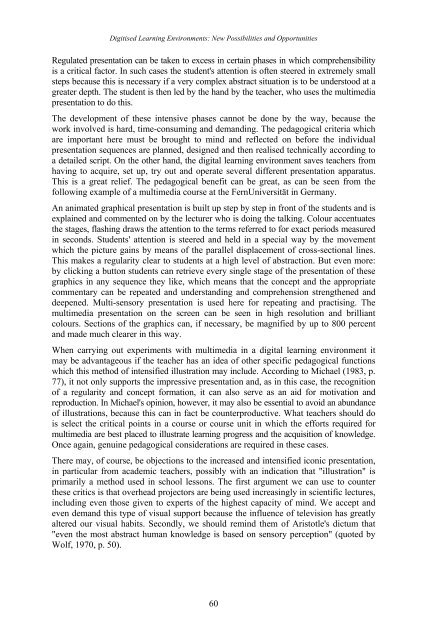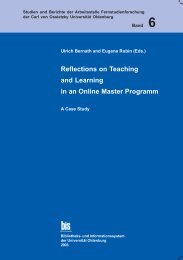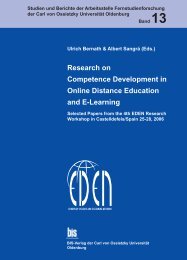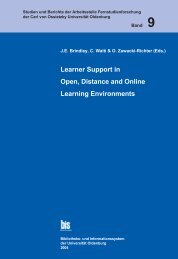Distance Education in Transition - Master of Distance Education ...
Distance Education in Transition - Master of Distance Education ...
Distance Education in Transition - Master of Distance Education ...
You also want an ePaper? Increase the reach of your titles
YUMPU automatically turns print PDFs into web optimized ePapers that Google loves.
Digitised Learn<strong>in</strong>g Environments: New Possibilities and Opportunities<br />
Regulated presentation can be taken to excess <strong>in</strong> certa<strong>in</strong> phases <strong>in</strong> which comprehensibility<br />
is a critical factor. In such cases the student's attention is <strong>of</strong>ten steered <strong>in</strong> extremely small<br />
steps because this is necessary if a very complex abstract situation is to be understood at a<br />
greater depth. The student is then led by the hand by the teacher, who uses the multimedia<br />
presentation to do this.<br />
The development <strong>of</strong> these <strong>in</strong>tensive phases cannot be done by the way, because the<br />
work <strong>in</strong>volved is hard, time-consum<strong>in</strong>g and demand<strong>in</strong>g. The pedagogical criteria which<br />
are important here must be brought to m<strong>in</strong>d and reflected on before the <strong>in</strong>dividual<br />
presentation sequences are planned, designed and then realised technically accord<strong>in</strong>g to<br />
a detailed script. On the other hand, the digital learn<strong>in</strong>g environment saves teachers from<br />
hav<strong>in</strong>g to acquire, set up, try out and operate several different presentation apparatus.<br />
This is a great relief. The pedagogical benefit can be great, as can be seen from the<br />
follow<strong>in</strong>g example <strong>of</strong> a multimedia course at the FernUniversität <strong>in</strong> Germany.<br />
An animated graphical presentation is built up step by step <strong>in</strong> front <strong>of</strong> the students and is<br />
expla<strong>in</strong>ed and commented on by the lecturer who is do<strong>in</strong>g the talk<strong>in</strong>g. Colour accentuates<br />
the stages, flash<strong>in</strong>g draws the attention to the terms referred to for exact periods measured<br />
<strong>in</strong> seconds. Students' attention is steered and held <strong>in</strong> a special way by the movement<br />
which the picture ga<strong>in</strong>s by means <strong>of</strong> the parallel displacement <strong>of</strong> cross-sectional l<strong>in</strong>es.<br />
This makes a regularity clear to students at a high level <strong>of</strong> abstraction. But even more:<br />
by click<strong>in</strong>g a button students can retrieve every s<strong>in</strong>gle stage <strong>of</strong> the presentation <strong>of</strong> these<br />
graphics <strong>in</strong> any sequence they like, which means that the concept and the appropriate<br />
commentary can be repeated and understand<strong>in</strong>g and comprehension strengthened and<br />
deepened. Multi-sensory presentation is used here for repeat<strong>in</strong>g and practis<strong>in</strong>g. The<br />
multimedia presentation on the screen can be seen <strong>in</strong> high resolution and brilliant<br />
colours. Sections <strong>of</strong> the graphics can, if necessary, be magnified by up to 800 percent<br />
and made much clearer <strong>in</strong> this way.<br />
When carry<strong>in</strong>g out experiments with multimedia <strong>in</strong> a digital learn<strong>in</strong>g environment it<br />
may be advantageous if the teacher has an idea <strong>of</strong> other specific pedagogical functions<br />
which this method <strong>of</strong> <strong>in</strong>tensified illustration may <strong>in</strong>clude. Accord<strong>in</strong>g to Michael (1983, p.<br />
77), it not only supports the impressive presentation and, as <strong>in</strong> this case, the recognition<br />
<strong>of</strong> a regularity and concept formation, it can also serve as an aid for motivation and<br />
reproduction. In Michael's op<strong>in</strong>ion, however, it may also be essential to avoid an abundance<br />
<strong>of</strong> illustrations, because this can <strong>in</strong> fact be counterproductive. What teachers should do<br />
is select the critical po<strong>in</strong>ts <strong>in</strong> a course or course unit <strong>in</strong> which the efforts required for<br />
multimedia are best placed to illustrate learn<strong>in</strong>g progress and the acquisition <strong>of</strong> knowledge.<br />
Once aga<strong>in</strong>, genu<strong>in</strong>e pedagogical considerations are required <strong>in</strong> these cases.<br />
There may, <strong>of</strong> course, be objections to the <strong>in</strong>creased and <strong>in</strong>tensified iconic presentation,<br />
<strong>in</strong> particular from academic teachers, possibly with an <strong>in</strong>dication that "illustration" is<br />
primarily a method used <strong>in</strong> school lessons. The first argument we can use to counter<br />
these critics is that overhead projectors are be<strong>in</strong>g used <strong>in</strong>creas<strong>in</strong>gly <strong>in</strong> scientific lectures,<br />
<strong>in</strong>clud<strong>in</strong>g even those given to experts <strong>of</strong> the highest capacity <strong>of</strong> m<strong>in</strong>d. We accept and<br />
even demand this type <strong>of</strong> visual support because the <strong>in</strong>fluence <strong>of</strong> television has greatly<br />
altered our visual habits. Secondly, we should rem<strong>in</strong>d them <strong>of</strong> Aristotle's dictum that<br />
"even the most abstract human knowledge is based on sensory perception" (quoted by<br />
Wolf, 1970, p. 50).<br />
60





